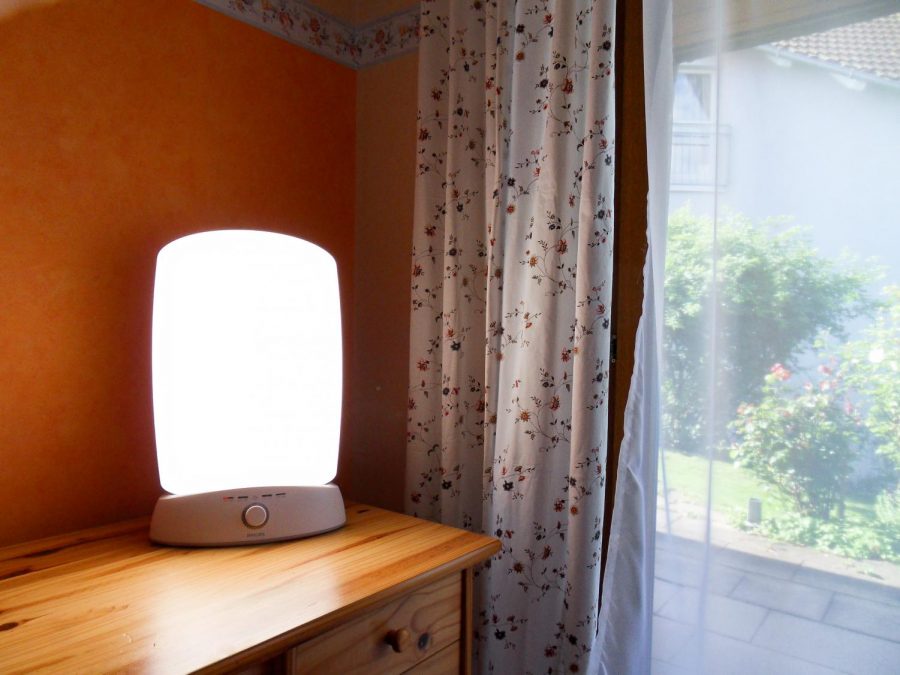Finding Your Light: SAD Lamps Fight Seasonal Affective Disorder
COURTESY OF WIKIPEDIA
SAD lamps are used to treat seasonal affective disorder through a practice called light therapy.
March 10, 2020
Individuals with depression often see therapists for treatment, but for those with seasonal affective disorder (SAD), it can also be effective to sit down for a light therapy session.
SAD is a type of depression that peaks during the late fall to winter months. Seeking a solution outside of antidepressants and traditional therapy, health professionals in the 1980s started prescribing light therapy to help alleviate SAD.
Light therapy involves exposing oneself to a high-intensity lamp to mimic the sun exposure one might receive in the summer. According to the National Institute of Mental Health (NIMH), people with SAD should sit next to a bright lamp every morning for 20 to 60 minutes. The lamps themselves should be about 20 times brighter than regular indoor light.
Before using a lamp to curb depressive symptoms, it’s important to distinguish between non-seasonal depression and SAD. The NIMH states that one must experience depression that arises in winter and goes away in summer for at least two years. If one goes through episodes of depression throughout the year, it’s likely that this depression isn’t associated with the decrease in daylight.
Some of the symptoms of depression include having less energy than usual, feelings of hopelessness or worthlessness and losing interest in activities one previously enjoyed. Symptoms specific to SAD are oversleeping, overeating, gaining weight, craving carbohydrates and withdrawing from social interaction.
One’s age, location, gender and history with affective disorders can be risk factors for SAD. In New York City, daylight hours can drop under six hours around the winter solstice and remain that way for many months afterward. For this reason, SAD rates are much lower in sunbelt states compared to northern states. Women are four times as likely to be diagnosed with SAD, and the affective disorder also affects younger people more.
All of these factors put Fordham students at particular risk for SAD, and some students use specialized lamps to treat their symptoms. Alissa Kerr, Fordham College at Lincoln Center (FCLC) ’21, uses a lamp from the brand Miroco. “It’s hard to tell if it’s just a placebo, but I often do feel more energized when I use it,” Kerr said.
Though she doesn’t use the lamp every day, she said, “I think if I used it consistently, it would be more effective, but the color of the light mimics sunlight, and I think that does have a positive effect on my mood.”
Two chemicals in the brain may play a key role in SAD, according to the NIMH. Melatonin is a hormone associated with sleep, and people with SAD experience higher levels of melatonin in their brains, causing them to sleep more and feel more lethargic. Light exposure regulates the release of this hormone, and it is involved in maintaining the circadian rhythm, or one’s sleep-wake cycles. It’s likely that the lower amounts of light exposure in the winter induce higher levels of melatonin.
The second chemical is serotonin, which is a molecule that regulates one’s feelings of wellbeing. Research indicates that individuals with SAD have more serotonin transporter protein that prevents the molecule from maintaining this feeling. Vitamin D is thought to be related to serotonin levels in the brain, and since we synthesize this molecule through our skin upon exposure to sunlight, our bodies make less of it in the winter months. Many factors affect serotonin levels, but the relationship between vitamin D and serotonin is likely a contributing factor to SAD in particular.
There are many different SAD lamps to choose from that uphold safety standards, according to the Mayo Clinic. Most importantly, SAD lamps should produce little to no ultraviolet light. The brighter, the better. Lamp therapy sessions will take up less time if one uses high intensity light producing lamps — the Mayo Clinic recommends around 10,000 lux for optimal effects. Individuals with preexisting eye conditions, like glaucoma, cataracts or eye damage from diabetes, should consult a doctor on choosing a lamp that will work best for them.
Though research consistently affirms the effectiveness of lamp therapy, SAD is a complicated psychological state to treat, and often requires many treatments at a time to alleviate symptoms. For this reason, consulting a healthcare professional is the best route to find a treatment plan that will work most effectively.











